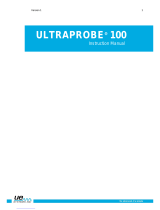Robinair TruTrack Ultrasonic Leak Detector 16455 User manual
- Type
- User manual
Robinair TruTrack Ultrasonic Leak Detector 16455 is a gas-independent device and can detect even dry nitrogen leaks. It is ideal to use for detecting both vacuum and pressure leaks of any refrigerant in air conditioning and refrigeration systems. The sound signature reproduction feature allows you to hear the actual translation of the detected sound. It is equipped with a contact probe accessory that helps detect sounds that are internally generated, such as abnormal flow in piping, leaks through bad valve seats, and steam trap leaks.
Robinair TruTrack Ultrasonic Leak Detector 16455 is a gas-independent device and can detect even dry nitrogen leaks. It is ideal to use for detecting both vacuum and pressure leaks of any refrigerant in air conditioning and refrigeration systems. The sound signature reproduction feature allows you to hear the actual translation of the detected sound. It is equipped with a contact probe accessory that helps detect sounds that are internally generated, such as abnormal flow in piping, leaks through bad valve seats, and steam trap leaks.
















-
 1
1
-
 2
2
-
 3
3
-
 4
4
-
 5
5
-
 6
6
-
 7
7
-
 8
8
-
 9
9
-
 10
10
-
 11
11
-
 12
12
-
 13
13
-
 14
14
-
 15
15
-
 16
16
Robinair TruTrack Ultrasonic Leak Detector 16455 User manual
- Type
- User manual
Robinair TruTrack Ultrasonic Leak Detector 16455 is a gas-independent device and can detect even dry nitrogen leaks. It is ideal to use for detecting both vacuum and pressure leaks of any refrigerant in air conditioning and refrigeration systems. The sound signature reproduction feature allows you to hear the actual translation of the detected sound. It is equipped with a contact probe accessory that helps detect sounds that are internally generated, such as abnormal flow in piping, leaks through bad valve seats, and steam trap leaks.
Ask a question and I''ll find the answer in the document
Finding information in a document is now easier with AI
Related papers
-
Robinair 16600 User manual
-
Robinair Recovery, Recycling, Recharging Unit 34288 User manual
-
Robinair 15400 Operating instructions
-
Robinair R1234yf User manual
-
Robinair Cool Tech High Performance Vacuum Pump 15434 User manual
-
Robinair 13203-1 User manual
-
Robinair 15600 User manual
-
Robinair High Performance Vacuum Pump 15401 User manual
-
Robinair High Performance Vacuum Pump 15444 User manual
-
Robinair 15120A User manual
Other documents
-
Guardian GLD1 Operating instructions
-
MasterCool 56200 Operating instructions
-
EASTMAN 98626 Installation guide
-
EZ-FLO 98580 Installation guide
-
Sharkoon RUSH HEADSET Datasheet
-
Amprobe AC-6500 Vacuum Leak Detector User manual
-
Yellow Jacket H2 Detector User manual
-
Trust 16451 Datasheet
-
Alpine VOLUME 1.3 User manual
-
 UE Systems Ultraprobe 100 User manual
UE Systems Ultraprobe 100 User manual
















